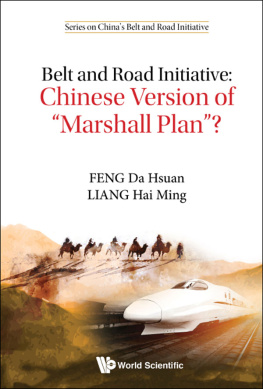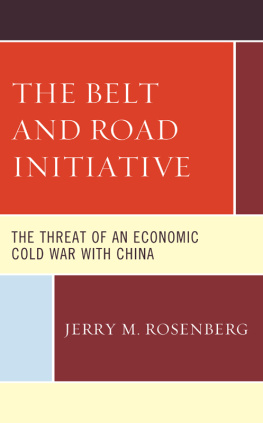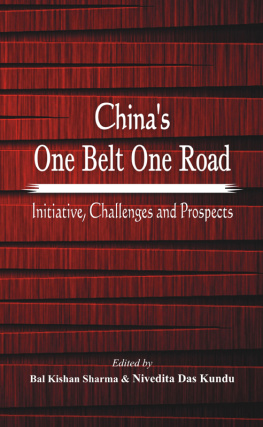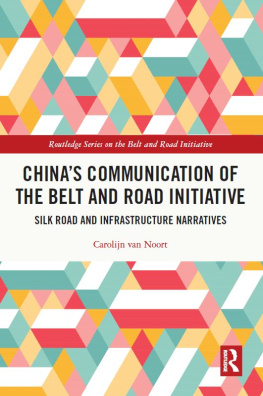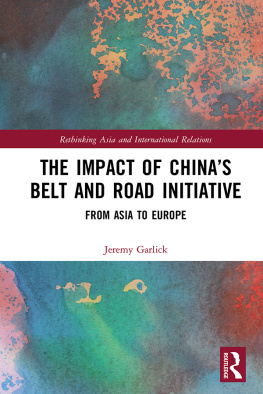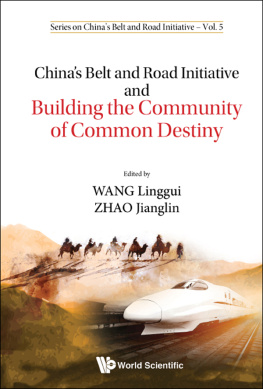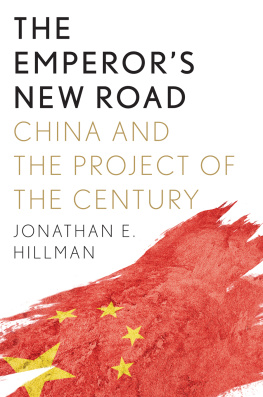
Series on Chinas Belt and Road Initiative
Print ISSN: 2591-7730
Online ISSN: 2591-7749
Series Editors:ZHENG Yongnian (National University of Singapore, Sinapore)
Kerry BROWN (Kings College London, UK)
WANG Yiwei (Renmin University of China, China)
LIU Weidong (Chinese Academy of Sciences, China)
This book series showcases the most up-to-date and significant research on Chinas Belt and Road Initiative (BRI) by leading scholars from inside and outside China. It presents a panoramic view on the BRI, from the perspectives of Chinas domestic policy, Chinas foreign investment, international relations, cultural cooperation and historical inheritance. As the first English book series on the BRI, this series offers a valuable English-language resource for researchers, policymakers, professionals and students to better understand the challenges and opportunities brought by the BRI.
Published:
Vol. 4Belt and Road Initiative: Chinese Version of Marshall Plan?
by Da Hsuan FENG and Hai Ming LIANG
Vol. 3Silk Road: The Study of Drama Culture
by LI Qiang
translated by GAO Fen
Vol. 2Chinas Belt and Road: The Initiative and Its Financial Focus
by YU Xugang, Cristiano RIZZI, Mario TETTAMANTI,
Fabio E. ZICCARDI and GUO Li
Vol. 1The Political Economy of Chinas Belt and Road Initiative
by ZOU Lei
translated by ZHANG Zhiping

Published by
World Scientific Publishing Co. Pte. Ltd.
5 Toh Tuck Link, Singapore 596224
USA office: 27 Warren Street, Suite 401-402, Hackensack, NJ 07601
UK office: 57 Shelton Street, Covent Garden, London WC2H 9HE
Library of Congress Cataloging-in-Publication Data
Names: Feng, Da Hsuan, 1945 author. | Liang, Hai Ming, author.
Title: Belt and road initiative : Chinese version of Marshall Plan? / Da Hsuan Feng (China Silk Road iValley Research Institute, China), Hai Ming Liang (China Silk Road iValley Research Institute, China).
Description: New Jersey : World Scientific, [2019] | Series: Series on Chinas Belt and Road Initiative, ISSN 2591-7730 ; vol. 4 | Includes bibliographical references.
Identifiers: LCCN 2018054796 | ISBN 9789811200502
Subjects: LCSH: China--Commercial policy. | China--Foreign economic relations. | Economic development--China. | Economic development--Developing countries.
Classification: LCC HF1604 .F428 2019 | DDC 381.30951--dc23
LC record available at https://lccn.loc.gov/2018054796
British Library Cataloguing-in-Publication Data
A catalogue record for this book is available from the British Library.
Copyright 2019 by World Scientific Publishing Co. Pte. Ltd.
All rights reserved. This book, or parts thereof, may not be reproduced in any form or by any means, electronic or mechanical, including photocopying, recording or any information storage and retrieval system now known or to be invented, without written permission from the publisher.
For photocopying of material in this volume, please pay a copying fee through the Copyright Clearance Center, Inc., 222 Rosewood Drive, Danvers, MA 01923, USA. In this case permission to photocopy is not required from the publisher.
For any available supplementary material, please visit
https://www.worldscientific.com/worldscibooks/10.1142/11285#t=suppl
Desk Editor: Tan Boon Hui
Typeset by Stallion Press
Email:
Printed in Singapore
Contents
Preface
Roughly two years ago, DHF and HML, the authors of this book, had one of their first conversations as follows. Without knowing it, that conversation became the underlying meaning of this book:
DHF: How can the United States work with China on the Belt and Road Initiative (BRI)?
HML: Well, lets think about it. China has kung fu and pandas, but it is the United States that has Kung Fu Panda!
The answer of HML may seem a bit whimsical. However, if one were to carry out a deeper analysis, one could easily recognize that it underlines two fundamentally and extensively discussed aspects of the BRI. The first is the concept of omnipresent economics and second is the millennium mindset transformation of China.
The first is the direct and inevitable outcome of the spectacular technological developments, mobile internet and smart devices, in the last and first decades of the 20th and 21st centuries, respectively. The second is Chinas long-term transition into the modern world, driven by BRI.
First, Kung Fu Panda is a movie. More importantly, it is also a business, whose success ultimately depends on reaching a vast number of viewers. That would require having the right economics. In September and October, 2013, when the BRI was proposed, the technology of the late 20th century, at a tipping point, was making a deep impact on the global economy. That technology is the seamless amalgamation of the ever-improving high-speed mobile internet and smart devices.
Some 40 years ago, the TV series Star Trek attained enormous global popularity simply because it fantasized how objects, humans included, could be transported from one point in space to another point in space, instantaneously. Clearly, the best word to describe such fantasies would be omnipresent!
Fast track to the present day, a palpable example of omnipresence is when in any Chinese metropolitans, when one had a few drinks and should not drive because DUI (driving under the influence) punishment is too severe, one could locate another person within minutes to take over the driving at the point where his/her car is parked. Such a business transition, which can be scaled up easily, is as close to the manifestation of omnipresence as possible. Indeed, the technologies of movable internet and smart devices have improved to the point where they could be operated in unison and nearly in real time! For this reason, we felt that referring to it as omnipresent economics is reasonable.
In of the book, we have the following quote:
In this arena, the US is no longer the leader today. China is. In fact, as far as internet and network payment arenas are concerned, in 2015, Chinas payment reached a whopping US$334 billion, which is three times higher than the US. Furthermore, the market size of this business in China is experiencing double-digit growth.
This statement underlines and defines the omnipresent economics as one of the BRI fundamentals. Many chapters in this book, in one way or another, deals with this aspect of BRI.
Second, as is well known, the martial arts, kung fu, is a profoundly rooted icon of Chinese culture. Panda, on the other hand, is an animal adored by the world and can only be found in south-central China. Yet, Kung Fu Panda is a Hollywood computer-animated action comedy martial arts film. It has successfully and deeply penetrated into the vast Chinese movie market. In a sense, the answer of HML to DHFs question can be thought of as the personification of what BRI is all about: it is when one nation deals with another, to profoundly understand that the populations ways and means of the other party must be placed first and foremost.
In the Han dynasty, the great Chinese explorer Zhang Qian () was bestowed by Baidu (the Chinese equivalent of Google) a great title, The first Chinese who observed the world with open eyes! Such an honor is equivalent to what David Naylor, the former President of the University of Toronto hoped the students from the University of Toronto could achieve: I hope my students would learn to understand the challenges of people of other cultures and ways and means, with their cultures and ways and means!

